
Amphora
Aleister Crowley's publication of ‘Amphora’; ‘Hail Mary’; and ‘Clouds without Water’
── Note the PDF file/ebook below! ──

⁂
Above is seen the surprising appearance of the anonymous Amphora in a Burns & Oates Catalogue from 1911 E.V.!
The story normally told is that the Roman Catholic publishers Burns & Oates discovered that Aleister Crowley had written the volume and withdrew their 1908 E.V. edition after that only a small number of copies had been sold. However, nobody seems to know exactly what happened.
It turns out that Amphora, which has the year 1908 E.V. on its title page, in fact, was published in December 1908 E.V., (and not in 1909 E.V. as later stated) and the book, bound in gilt stamped blue cloth, was sent out for reviews the week before Christmas.
The London publisher had overlooked several things in the book, among other things, strong lesbian undertones! They apparently returned the unbound sheets to Crowley, perhaps sold them to him, and The Equinox and Wieland and Co. published in October 1911 E.V. these sheets – with a new title page that bore Crowley’s name – as Hail Mary.
Amphora, strangely enough, continued to be listed in Burns & Oates’ catalogues, where it appeared both in 1909 E.V.; 1910 E.V.; and 1911 E.V.! The great question is whether Burns & Oates continued to sell bound copies of the book? The fact that the book is extremely scarce speaks against it. However, their listing of Amphora first stopped after the publication of Hail Mary. But if Burns & Oates had continued to sell the book, which apparently was well received, why then had the unbound sheets which became Hail Mary not been bound?
Below is seen the title page of the privately printed, undated, anonymous edition of Amphora – “Privately Printed for the Authoress and Her Intimates”, which Aleister Crowley apparently had commissioned just after that Burns & Oates’ edition of the same work had been printed – both editions were printed by the same printer, and apparently printed from the same formes! The only difference between the two editions was that Crowley in his Privately Printed edition had included an epilogue where the initial letters of the first and last word in each line revealed an obscene statement! However, at that time Crowley only knew this secret.
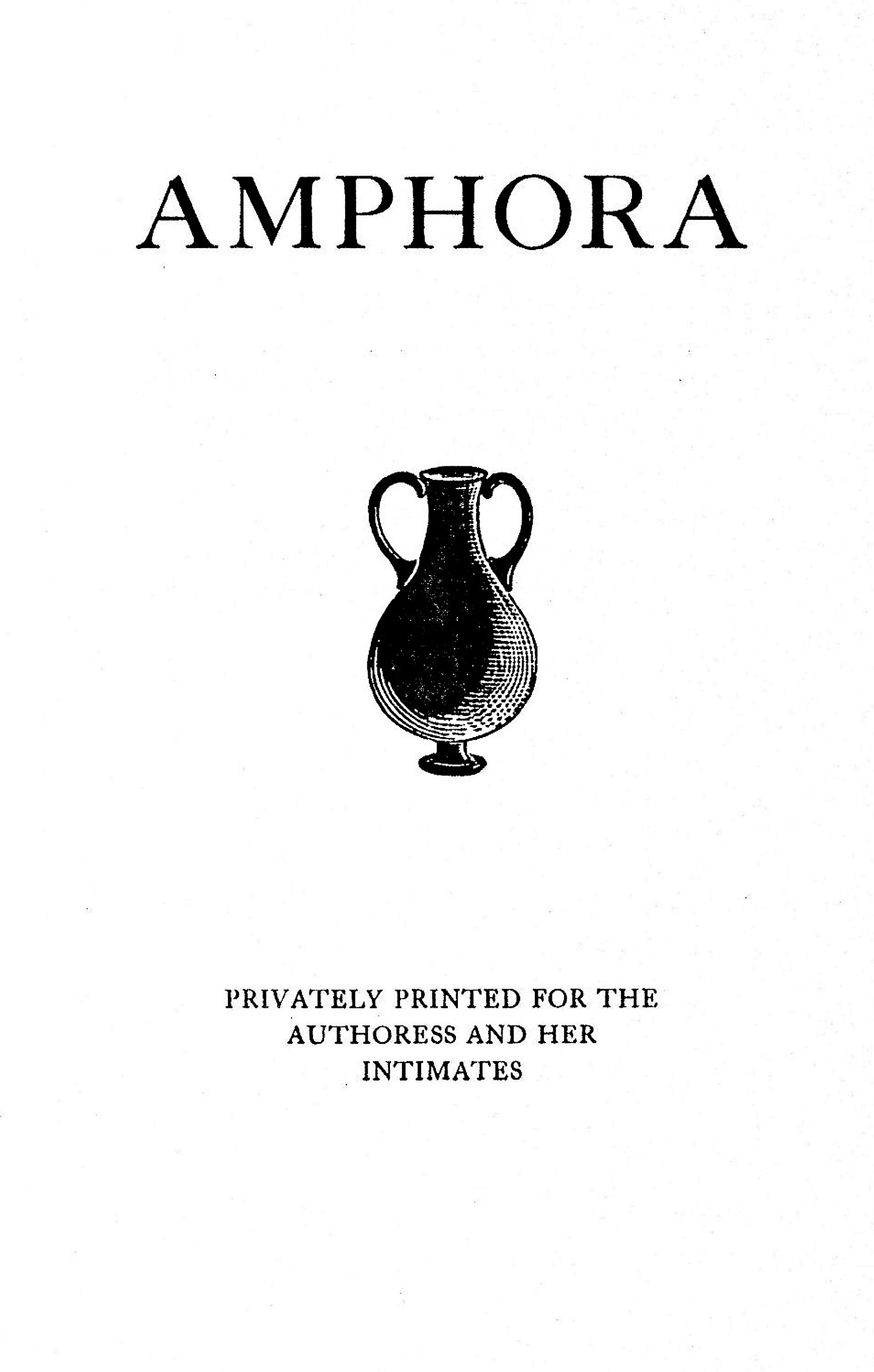
• Title page of the anonymous Amphora, "Privately Printed for the Authoress and Her Intimates".
• Discover strange and interesting new things about two of Aleister Crowley’s rare (erotic) works, the "jokes" Amphora and Clouds without Water.
Discover why Crowley perhaps published his Clouds without Water stating that it was "Edited from a Private M.S. by the Rev. C. Verey”, and that it was “Privately Printed for Circulation Among Ministers of Religion”! – Read online or download this PDF file/ebook (18 pp.) containing an illustrated extract from FOR THE THELEMITES. [May need further proof reading]
(In connection with this extract, see also the extracts "Ye Sword of Song" and "February 1913 E.V."!)
Corrected version. Read online or download (Acrobat 9.0 and later):
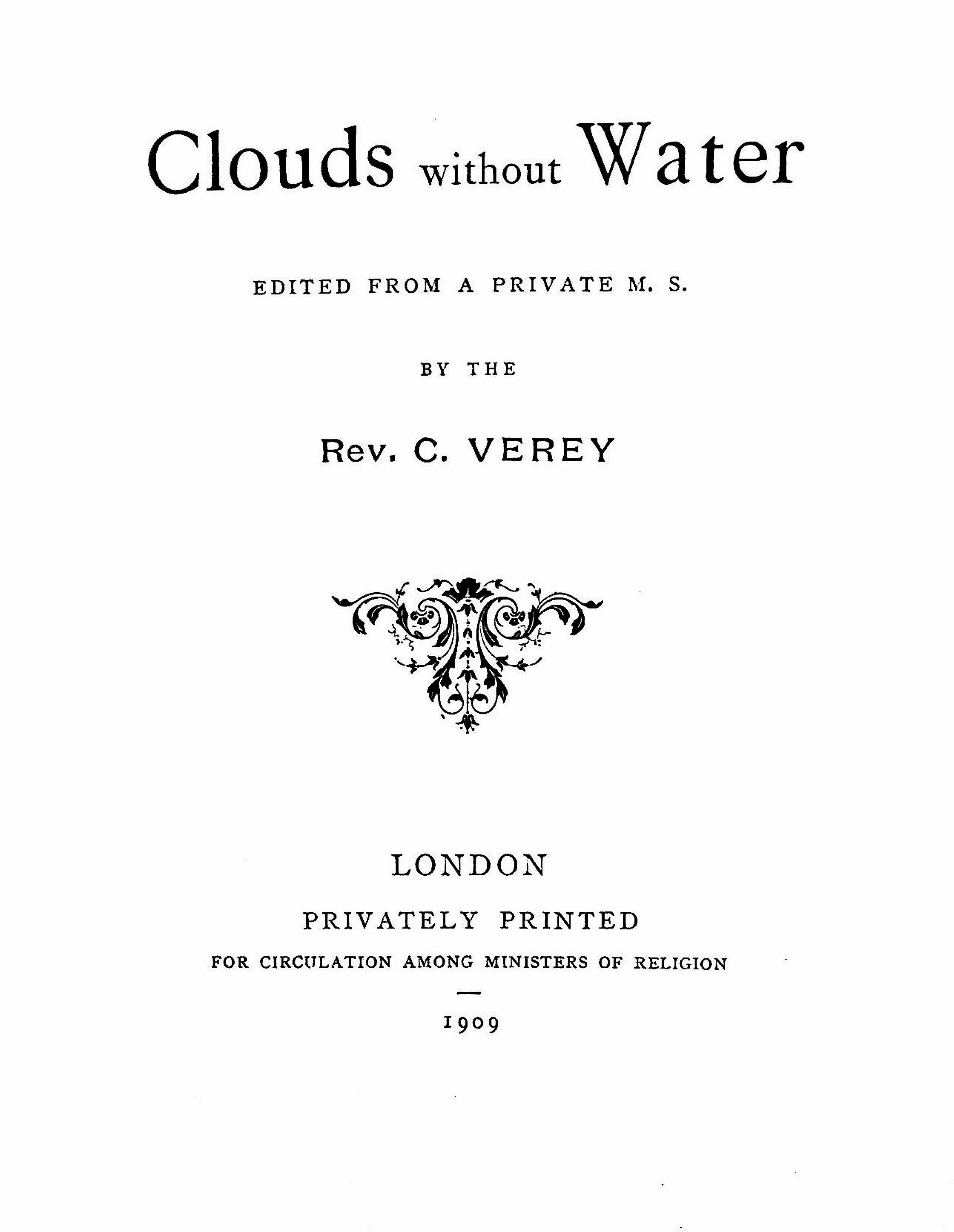
• Title page of Clouds without Water – “Edited from a Private M. S. by the Rev. C. Verey” and “Privately Printed For Circulation Among Ministers of Religion, 1909.” The work is dedicated to the memory of Marguerite Porrete – a beguine mystic, author of a work dealing with the workings of Divine Love, that was burnt at Paris in 1310.
The words “Clouds without Water”, as found in the Old Testament in The Book of Proverbs 25:14, and in the New Testament in The Epistle of Jude 12, symbolize a person who promises much but does not perform.
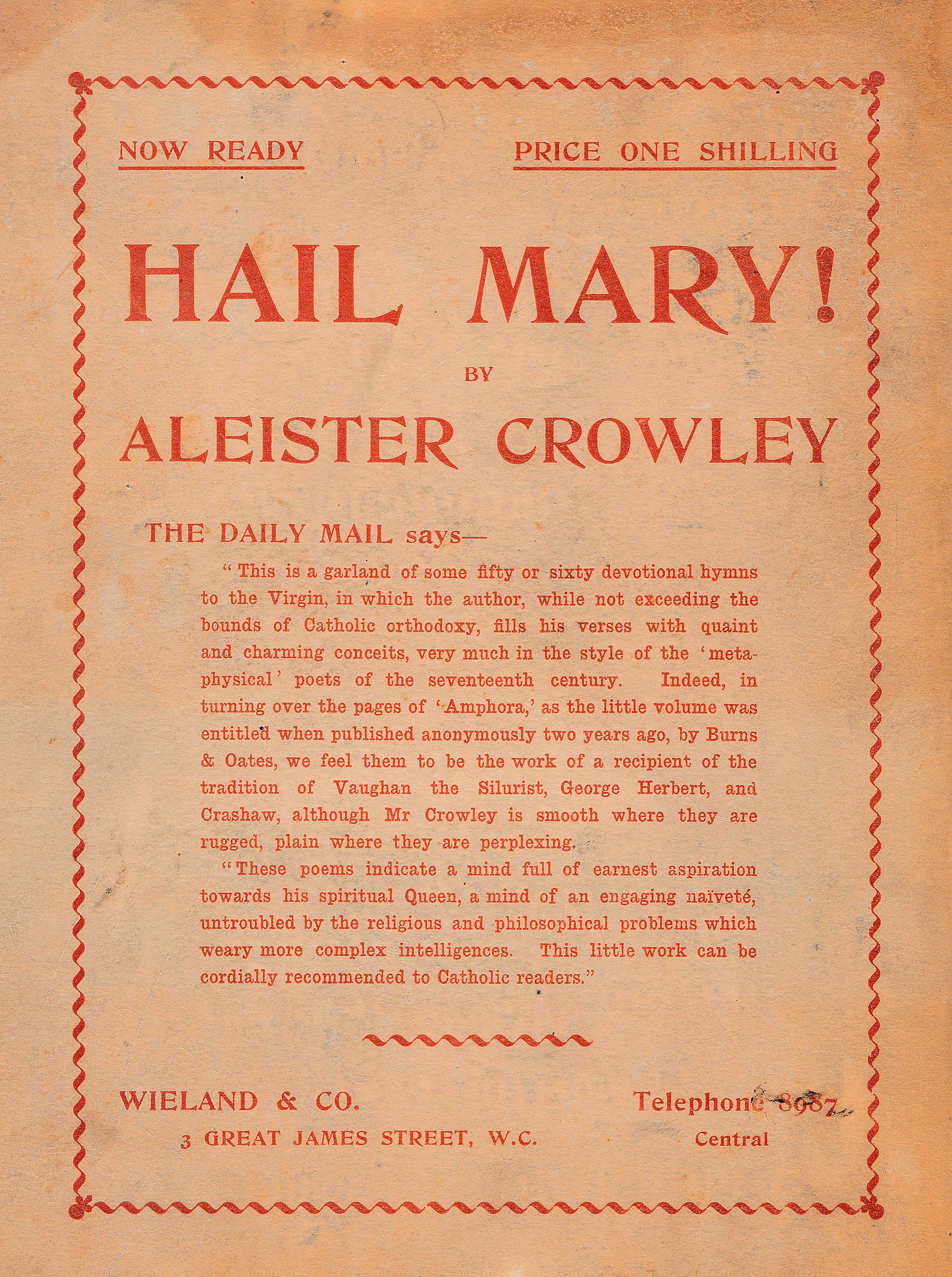
• Advertisement for Hail Mary (Amphora) on the outside of the back cover of the seventh number of The Equinox, March 1912 E.V. However, although here stated as "Now Ready", the book had, in fact, been published by Wieland & Co. in October 1911 E.V.
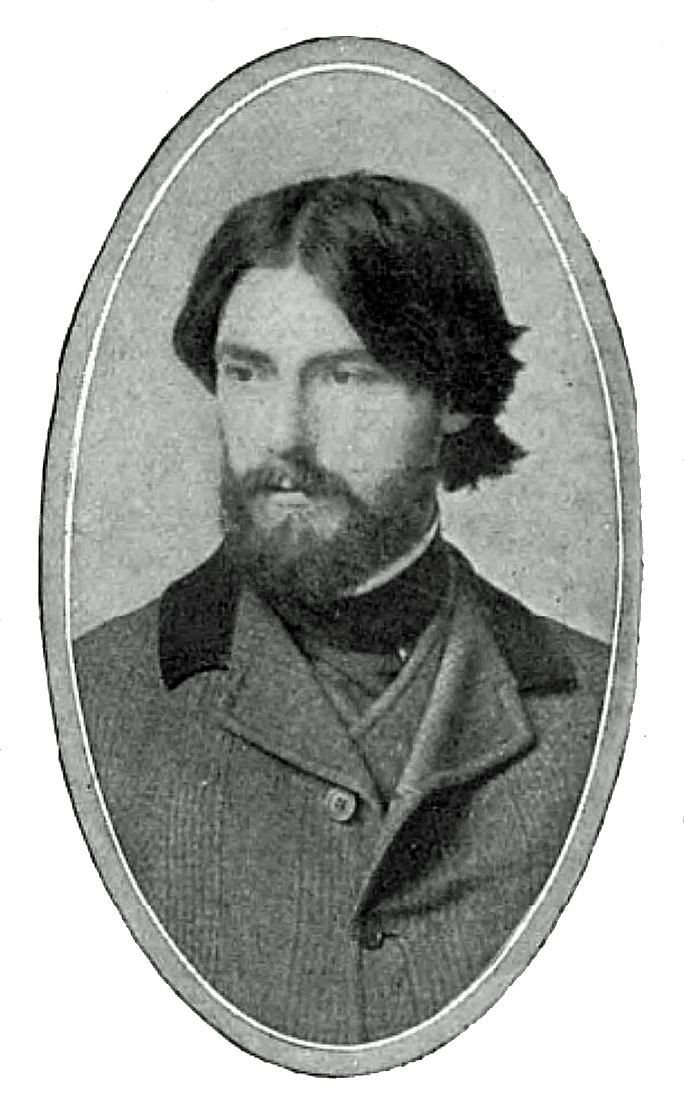
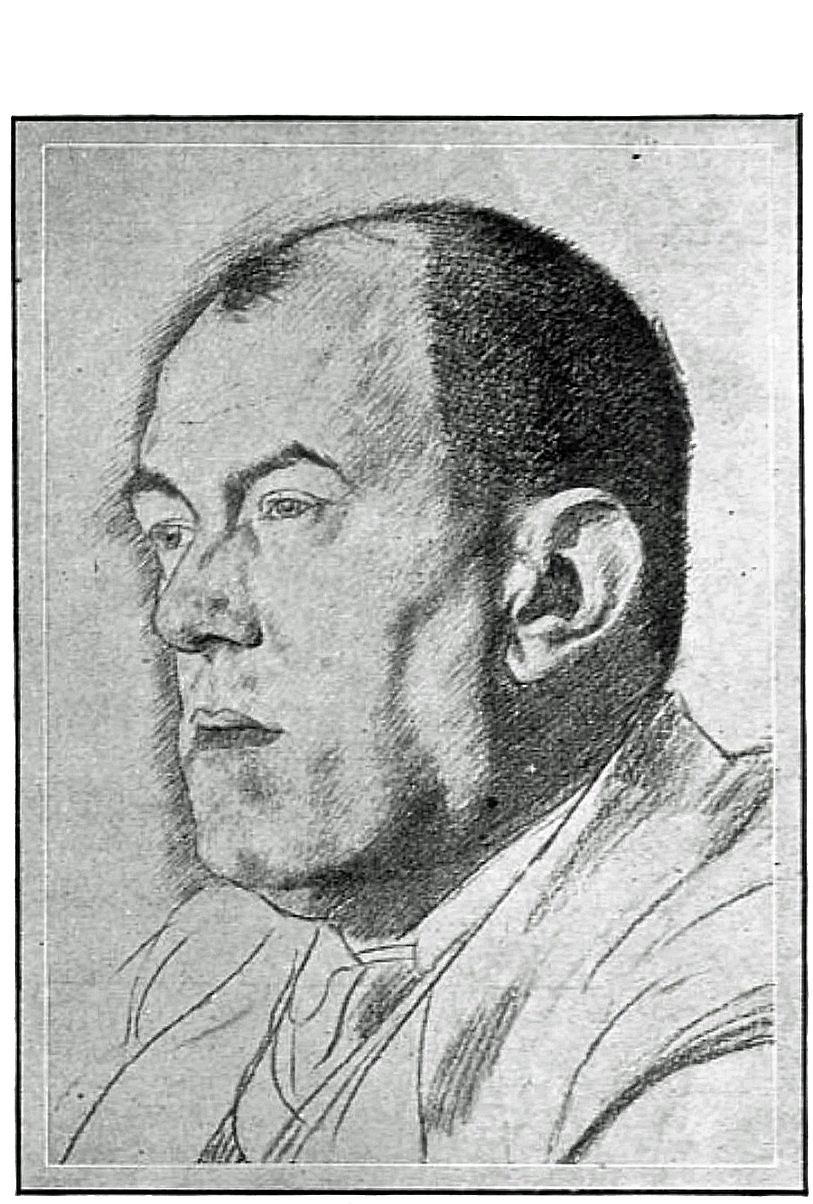
• Augustus John, 1911 E.V. (left), and a photograph of the drawing ‘THE HEAD OF A POET’ (right) from his exhibition at the Chenil Gallery, Chelsea, London, in December 1911 E.V. Author's collection.
⁂
A few months after that the publication of Hail Mary had taken place the Welsh painter and draughtsman Augustus John (1878-1961)(above, left), exhibited in December 1911 E.V. at the Chenil Gallery, Chelsea, London, and among the works was a drawing of Aleister Crowley (above, right). However, it was not mentioned that it was Aleister Crowley, and its title just stated: “THE HEAD OF A POET”. It seems that none of the newspapers and magazines that wrote about the exhibition knew that this poet was “The Beast 666”. The drawing – graphite on off-white wove paper, measuring 44.9 x 27 cm – is today at the Harvard Art Museums/Fogg Museum in Cambridge, Massachusetts. It was bought by Grenville L.(indall) Winthrop (1864-1943), a New York City lawyer and art collector, in 1924 E.V. He bequeathed his entire art collection to the Fogg Art Museum in 1943 E.V. For the above, together with another of Augustus John's drawings of Aleister Crowley, also dating from 1911 E.V., see the PDF file/ebook on the page "Confessions, 1929 E.V."
⁂
An overlooked memory of Aleister Crowley.
I once stumbled on an overlooked memory of Aleister Crowley from around 1906-1910 E.V. In the book I Live Again: Travel, Secret Service and Soldiering in India and the Near East, published in 1938 E.V., Royal Air Force Squadron Leader Arthur Rowan (1888-1968), writes:
Of the distinguished visitors who came now and then to speak at society meetings in Cambridge, two particularly impressed me: G. K. Chesterton and Aleister Crowley. As many readers will know, “G.K.” had a habit, while speaking, of taking off his pince-nez and playing with them. On this occasion they snapped in his hand. I was sitting in the front row, also wearing pince-nez, and it looked to me as if mine were of much the same type. I offered them to him, and they proved identical with his. Afterwards he asked me if he might be allowed to return them when he got back to London. I was delighted, of course, but my pleasure waned a little when they turned up in an envelope — broken!
A very different character was Aleister Crowley, of the hypnotic eyes and remarkable learning. At the time of our meeting he was an ardent Rosicrucian and a prolific writer. I regarded Crowley much as did the reviewer of his books, who wrote: “Here is a master voice in song; here is a hand which has ‘waked to ecstasy the living lyre.’ It has indeed been the lot of few men to be the author of thirty-two books and still remain unknown; but it has been the lot of none to sing songs of so divine a melody and so diabolic a discord.”
One day Crowley said to me: “You are interested in mysticism, why don’t you join me? I am shortly going to celebrate the rites of Venus and Mars in a hall in Holborn.” I was tempted, but said no. When we parted he gave me the one hundred and first copy, signed by himself, of his remarkable book Konx om Pax or Essays in Light. I have ever since followed the development of his singular character, and personally I am convinced that some of his poetry will live.
(Arthur Rowan. I Live Again: Travel, Secret Service and Soldiering in India and the Near East. London, UK: Robert Hale Limited, MCMXXXVIII (1938), pp. 22-3.)
– Rowan recalls Crowley saying that “I am shortly going to celebrate the rites of Venus and Mars in a hall in Holborn.” The Rites of Eleusis were celebrated at Caxton Hall in Westminster in London in October and November of 1910 E.V. – the rites of Mars and Venus both in November – but perhaps Crowley at the time of his meeting with Arthur Rowan thought of a hall in Holborn.
(An extract from For the Thelemites, Chapter 12, but here printed without notes indicating sources etc.)
⁕
Just a note to the above statements by Arthur Rowan. During the First World War Rowan was shot down and taken prisoner in Bulgaria! Ask yourself this question: If Aleister Crowley’s work in America during WW1 had made him a traitor do you then think that the British soldier and spy-catcher Arthur Rowan would have written the above about him in 1938 E.V.?!
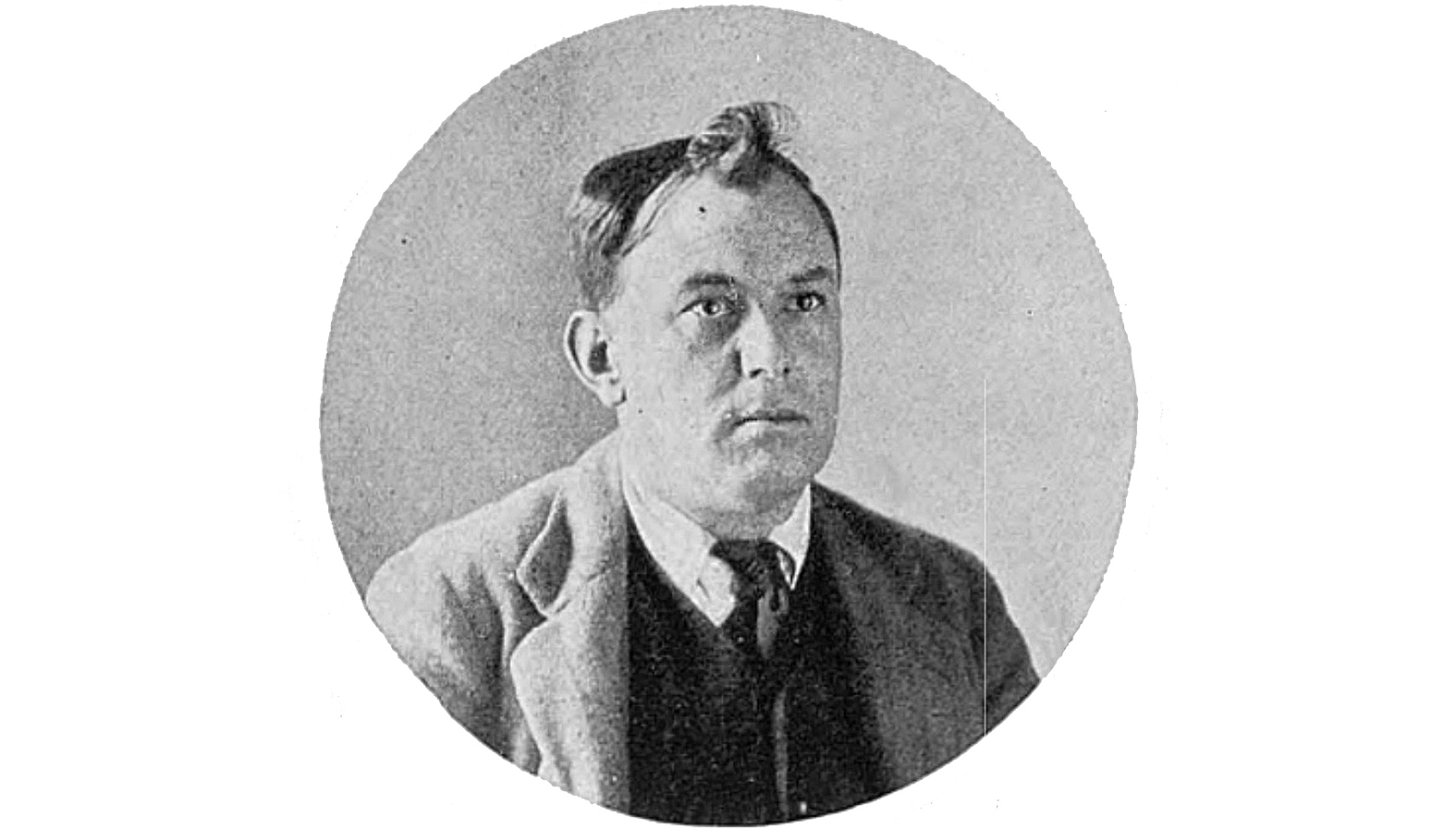
• Aleister Crowley 1910 E.V.
⁂
Who was Arthur Rowan who had been tempted to follow Aleister Crowley? He was born in 1888 at the Schlossli (castle), Schloss Binningen near Basel in Switzerland – a castle that his father owned for eleven years. He was the eldest son of Irish railway engineer William Robert Rowan (1841-1900), and Danish-born Gerdine Atalia Rowan, née Jacobsen (1851-1939). In 1898, when Arthur was about eleven, his father was appointed consulting engineer to the French Government and the family moved to France. In 1901, after his father’s death the year before, his mother together with his three brothers and two sisters went to England where he was sent to Bedford public school. In October 1905 E.V. he matriculated at Corpus Christi College, Cambridge, reading Medieval and Modern Languages. Due to his family’s finances Arthur Rowan could not complete the three years at Cambridge and he left – apparently during his third year, 1908 E.V. – without taking a degree. It was apparently after that he had left Cambridge that Crowley mentioned the rites of Venus and Mars to him and gave him the copy of Konx Om Pax.
Rowan did not join Aleister Crowley. On his mother's recommendation he instead went to India becoming a superintendent in a post office. He came back to England in 1915 E.V. to join up and became a Lieutenant in the King's Royal Rifle Corps. He went to Salonika where he became interested in flying and was transferred to the Royal Flying Corps as an observer. Rowan was during the First World War shot down and taken prisoner in Bulgaria. He was reported missing on January 3, 1918 E.V. – 10 months before the war ended. Apart from being a pilot and Lord Trenchard’s A.D.C. – Lord Trenchard (1873-1956), the “Father of the Royal Air Force” – Rowan was also a spy-catcher. In 1923 E.V., as a Flight Lieutenant, he married Violette Colleen Mary MacHutchin (b. 1900), only daughter of Colin MacHutchin, retired Deputy Director Surveys, Madras, of Totland Bay, Isle of Wright. Rowan had a strong interest in Magic and Mysticism and learned Yoga in India. For several years he was stationed in India, and from 1928-32 E.V. in Cairo. In 1935 E.V., as a Squadron Leader, he retired, but was recalled in 1939 E.V. After WW2 he taught languages at The King’s School Chester. The soldier, traveller, and teacher Arthur Rowan, who also was a Fellow of the Royal Geographical Society, died on June 6, 1968 E.V., in Chester, Cheshire, England, aged 80. Arthur Rowan's younger brother was William Rowan FRSC (1891-1957), a Canadian biologist and ornithologist.
(An extract from For the Thelemites, Chapter 12, but here printed without notes indicating sources etc.)
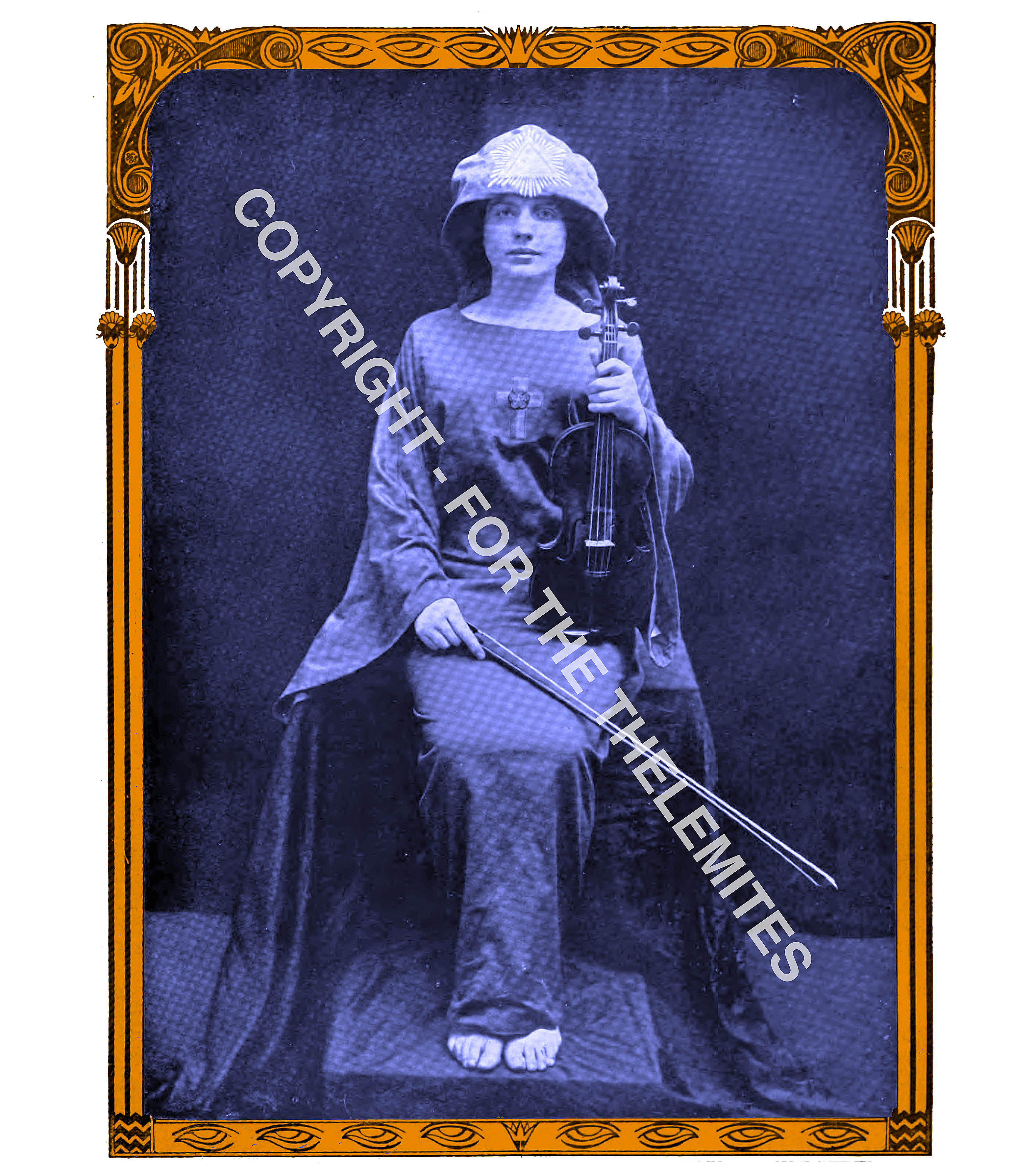
• The Rites of Eleusis, mentioned above, were seven rituals, one for each of the planets in traditional astrology (Saturn; Jupiter; Mars; Sol; Venus; Mercury; and Luna), performed at Caxton Hall, Westminster, London, on Wednesdays from October 19 to November 30, 1910 E.V.: “Miss Leila Waddell and Mr. Aleister Crowley with Distinguished Assistance”. Seen on the picture is “The Goddess”, Australian violinist and A .·.A .·. Soror Leila (Ida) (Nerissa) (Bathurst) Waddell (1880-1932).
⁂
The following article dealing with the Rites of Eleusis [Rite of Saturn] appeared in Horatio Bottomley’s pennyworth John Bull on November 5th, 1910 E.V. [Probably written by the English journalist Herbert Vivian (1865-1940), who had reviewed Konx Om Pax in the weekly back in 1908 E.V.]
IS A NEW SMYTH-PIGOTT AMONG US?
_______________
MR ALEISTER CROWLEY’S BLASPHEMOUS AND PRURIENT PROPAGANDA.
_______________
A “new religion” is usually viewed with suspicion in this country, but Mr. Aleister Crowley is just the person for such an enterprise. He is a man of good birth and education, with distinguished, almost pontifical, manners. He has travelled over all the unusual parts of the world and investigated fantastic things with real zeal, if not with discretion. He has probed the secret recesses of most Oriental religions and has made a special study of all the endless literature of magic and mysticism. Though he has never yet succeeded in catching the long ear of the public, he has been a voluminous writer, and has published works which fill many shelves. “Konx Om Pax” and “777” have already been noticed in this journal. To the uninitiated, they appear like the outpourings of an extremely clever lunatic, now solemnly revealing the secrets of the ancients, now running off into the most delightful nonsense, now assuming the role of the preacher, now frankly pulling legs. His chief efforts have been concentrated upon the composition of really remarkable poetry. His rhythm and metre and melody are often quite perfect, and as a lord of language he runs Swinburne very close. Often he goes very near to the borderland of insanity.
His work, however, is spoiled by the intrusion of wild, erotic, and disgusting images and startling blasphemies, which restrict his writing to private circulation, though it possesses an artistic enchantment quite apart from its appeal to pruriency and debauchery.
His present “mission” was heralded in March of last year by a portly publication called The Equinox. The idea, evidently, is to attract the public to the teachings of mediæval alchemists or magicians. The propaganda consists in assembling a number of ladies and gentlemen in a dark room, where poems are recited in sonorous tones and a violin is playing with considerable expression, amid choking clouds of incense, varied by barbaric dances, sensational interludes of melodrama, blasphemy and erotic suggestion.
OUR REPRESENTATIVE’S REPORT.
By special favour, or good fortune, or both, I was able to get free admission into the chamber of mysteries, which others less fortunate than I could not enter without paying in advance a fee of £5. In the corridor there stood none other than Aleister Crowley himself – a man of fine physique and with all the appearance of an actor – in a long white garment, which reminded one of a cassock one moment and a Roman tunic the next, although undoubtedly it was neither the one nor the other. He vanished as mysteriously as he had appeared. Then there came among us, for a few brief seconds, a woman, young, with strong features set in a deathly pale face. Someone said, “That is Lelia [sic] Woddell [sic]. She plays the violin and takes the chief part in the mystic stance.”
A few of my own sex, in evening frocks, some looking as though they were strangers in the place, were enquiring for the dressing-room, and were informed there was only one such room, used by both sexes. A figure in a brown, monk-like frock, with face completely hidden by a cowl, passed among us, handing around type-written sheets explanatory of the performance, and then it was time to visit the mystic chamber.
“MASTER OF THE TEMPLE ” AND ”MOTHER OF HEAVEN.”
The room was in semi-darkness, a bluish light hanging from the ceiling at the far end, a heavy smell of incense pervading the air, while the solemn stillness and hushed voices helped to enhance the weirdness of the place. I was taken to the front row, and a large cushion was given me to sit on. There were evidently no rules as to the pose one should adopt, for during the evening I saw some very Bohemian attitudes. To say the least, the cushions were not conducive to comfort, but those people behind me fared worse still. They sat on low wicker and bamboo footstools; several of these gave way during the performance, letting the unsuspecting occupants down, and not too gently! Presently the door was closed and locked, the low blue light felt pale and mystical upon a male figure sitting behind a cauldron, with a drum between his knees; he beat the drum with his hands, paused, and then resumed the beating, and from a small door behind him entered a number of male and female figures, ten or twelve, clothed some in white, some in brown. He ceased to beat the drum, and one of the male figures then performed the “vanishing ritual of the Pentogram [sic],” which is design to keep away evil influences. He then lighted a fire in the cauldron, and crouching behind, recited. Next, he joined with the brethren in an endeavour to rouse someone whom they called the “Master of the Temple.” I could not refrain from a feeling of envy at his ability to slumber through such a din! They failed to wake him, and the same brother appealed to the “Mother of Heaven.” She appeared in the person of Lelia [sic] Woddell [sic], played an invocation, and the “Master of the Temple” was at last aroused. I was not surprised!
OUR REPRESENTATIVE EMBRACED.
He came forward, crouched behind the cauldron, and recited a most blood-curdling composition, filled with horrible allusions to “the stony stare of dead men’s eyes,” &c., &c. After all, one couldn’t blame him for getting angry at being disturbed, I suppose. However, suddenly he lifted what looked like a tin of Nestlé’s milk, and pouring the contents on the flame, extinguished the fire, declared that “there is no God,” that everybody was free to do just as he or she liked, and left the audience in utter darkness! Not the slightest ray of light entered the room, and the atmosphere seemed heavier and more oppressive than ever. There was a sound as of people moving quietly about, which added to the uncanniness. How long this lasted I do not know, but all of a sudden an arm was placed round my neck, and a moustache pressed to my cheek – someone had kissed me!
THE DEAD MEN FED.
The next moment the blue light appeared. The mystical figures were moving before me, and I watched, fascinated. The presence of a traitor among them was suspected, and a man clad in white, sword in hand, sought this traitor among the crouching figures. What a weird picture it was! With an unearthly scream he sprang upon one of the male figures, and, dragging him forth, “slew” him before our eyes. After this there was more violin music, and a wild barbaric dance in the misty, smoky blue light. One little scene that chilled my blood occurred when the lights were extinguished. In the utter darkness, and after a long pause, in which one could hear one’s own heart beat, a male voice, a terrible voice, called out: “My brethren, are the dead men fed?” “Yes, verily, the dead men are fed,” came the reply. “My brethren, upon what have the dead men fed?” “Upon the corpses of their children” was the horrible answer. I had had enough, and was heartily glad when it was all over.
(John Bull. London, England: John Bull. • (Saturday,) November 5th, 1910, p. 707. (IS A NEW SMYTH-PIGOTT AMONG US? – MR: ALEISTER CROWLEY’S BLASPHEMOUS AND PRURIENT PROPAGANDA, p. 707.))
The Word of the Law is θελημα – Do what thou wilt shall be the whole of the Law
Φ
Copyright © Perdurabo ST — All Rights Reserved 2026 E.V.